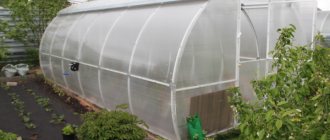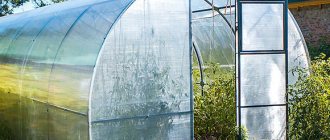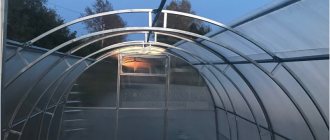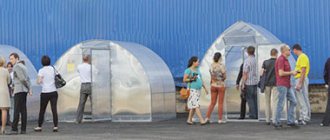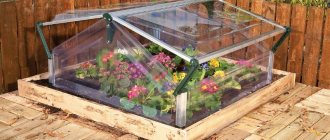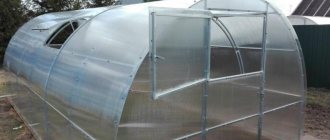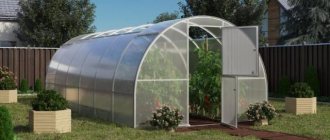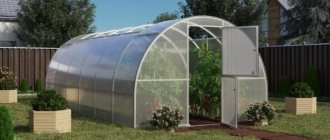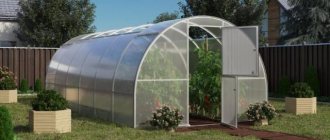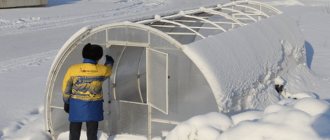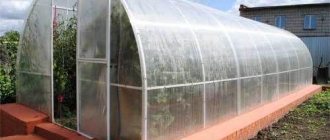The “Nurse-Umnitsa” greenhouse is a modern design produced by the Novosibirsk Metal-Service plant. Often, the choice of greenhouses turns into a serious problem for summer residents and gardeners, especially for residents of regions with cold climates. Such a design should reliably protect the grown plants from sudden temperature changes and winds, while at the same time remaining multifunctional and suitable for cultivating early types of herbs and vegetables. All these requirements are met by “Nurse-Umnitsa”, which has gained popularity among summer residents and owners of personal plots.
Selection and operation
The classic nurse-clever greenhouse or options with a removable top part are convenient and practical, but any type of structure must be installed correctly, as well as provide comfortable conditions for the plants.
In this case, the soil, the location of the product, the irrigation system, and the illumination of the area play an important role. All factors should be taken into account when installing a greenhouse with a sliding top or a classic type structure. This approach will ensure a high-quality, rich harvest and eliminate many problems during the growth and development of plants. When choosing a nurse-clever greenhouse with a sliding roof, you should consider the following features:
- Dimensions and shape of the structure. There are small compact models and larger ones. Each option has certain characteristics, and the choice depends on the area of the site, the required volume of plantings and other factors;
- . ;
- The quality of the frame elements, polycarbonate and all parts of the mechanism is an important factor, because the ease of use and durability of the greenhouse depend on it;
- To assemble it yourself, you should take into account the complexity of the product, the number of parts and the type of mechanism for opening the top part.
A wide variety of greenhouse options makes it easy to find the optimal type. The cost of a nurse with a sliding roof depends on the quality of the frame elements and the density of the polycarbonate, the size and complexity, and the manufacturer. That is why it is worth first determining the necessary parameters that a greenhouse with a removable roof should have, and then purchasing the product.
The installation of a sliding structure deserves special attention. It is first necessary to determine the location on the site where the nurse-clever greenhouse will be installed. Free and well-lit space, the absence of parts that interfere with the comfortable operation of the greenhouse, as well as the close location of the irrigation system are the main important points. A high-quality greenhouse with a sliding roof is installed according to the instructions and taking into account all the features of the frame elements. The operation of these structures involves regular cleaning, repair and adjustment of mechanisms and polycarbonate surfaces. Any greenhouse with an opening top requires careful and correct installation. Before planting and after harvesting, the walls of the greenhouse with a sliding or removable polycarbonate roof should be thoroughly treated with disinfectant compounds. The soil also needs preparation and cultivation. Thanks to a simple set of measures, a clever nurse, that is, a greenhouse with an opening top, will ensure a rich harvest.
DIY greenhouse
Given the low cost of the simplest nurses, with the possibility of their subsequent radical modernization, the process of building such a greenhouse with your own hands seems somewhat doubtful. But if we are talking about improving consumer characteristics or seriously increasing the service life of a structure, it definitely makes sense.
First of all, we can talk about the frame material. If the greenhouse is regularly and effectively ventilated, then it makes sense to consider wood in this capacity.
- Firstly, wood is more resistant to static loads: it bends, but does not break, and after they are removed, it restores its original configuration better than metal.
- Secondly, it is much easier to work with than metal.
- Thirdly, with appropriate treatment, it can last longer than metal, and if you take larch, then many times longer.
You can also use polypropylene water pipes for the frame of the “Nurse” type greenhouse.
The only thing we would recommend to improve is their connection. The use of standard welding and standard components for such systems will be much more justified. At the same time, it would be rational to introduce either steel reinforcement of the appropriate diameter or its fiberglass analogue into the arched elements of the frame, which is even better. The durability of this design is beyond doubt. Also, pipes can be secured using the same crabs with various options for their use.
And finally, to stimulate your creative searches - a selection of options for replacing polycarbonate.
This coating will not last very long with constant exposure to ultraviolet radiation, but certainly no less than polycarbonate.
We recommend other articles on the topic
Construction of a drip irrigation system at the dacha
How to fence the beds? - types of borders for garden beds
Principles of hydroponics, making a hydroponic installation with your own hands
Advantages of the “Nurse” greenhouse
National team greenhouse: description, reviews, tips for assembling a reinforced model
- The frame parts are made using welded joints, with seams placed on each side of the profile. This allows the greenhouse to withstand the harsh weather conditions characteristic of various regions of our country - strong winds, heavy snowfall, hail.
- The doors and windows are designed so that it is as convenient as possible for the owners to work with the greenhouse. The width of the door allows you to easily carry boxes of seedlings, fertilizers, buckets, etc. It is possible to install two doors - at each end of the greenhouse, as well as two windows - for effective ventilation.
- In the production of "Nurse" greenhouses, only high-quality modern equipment is used. Thanks to this, all structural parts are perfectly smooth and of precise dimensions, which makes assembly easy.
- The metal parts of the greenhouse are treated with a polymer coating, which protects the frame from moisture, fumes, chemicals used inside the greenhouse, as well as from external factors.
- The thickness of the pipe wall that makes up the greenhouse frame ensures its rigidity and resistance of the structure to mechanical loads and harsh climatic conditions.
- The height of the greenhouse makes it possible to care for plants comfortably.
- Since you choose the size of the greenhouse yourself, you can think in advance about its location and the convenience of placing doors. The construction on your site will be the most efficient.
- Detailed instructions and a carefully thought-out design of the greenhouse allow it to be assembled by any summer resident in literally half a day. Using anchors, you can install the greenhouse directly on the ground, and, if desired, equip it with a monolithic concrete foundation or a simpler foundation made of timber. Both options will increase the stability of the structure and its durability.
- When disassembled, the “Nurse” greenhouse can be easily transported on the roof rack or in a station wagon car.
- Polycarbonate coating has undeniable advantages over polyethylene film or glass. Polycarbonate is much stronger and more durable, quite dense, but flexible. Cellular polycarbonate provides plants in the greenhouse with a comfortable microclimate, and installing such a covering is very simple. There is no need to remove the covering for the winter.
The "Nurse" greenhouse is one of the best greenhouses produced in Novosibirsk. Every gardener can be convinced of its advantages by installing the “Nurse” on his plot.
You can also read:
Growing flowers in a greenhouse and caring for them
Greenhouses Krepysh - description and assembly instructions
Weaving polycarbonate greenhouse - assembly and features
Manufacturers
Greenhouse "Kremlin"
The history of the production of “Nurse-Umnitsa” is connected with the Metal-Service enterprise, located in Novosibirsk. For many years, the company has been producing traditional greenhouses and metal structures, but in 2008 it began developing a new, improved design, taking into account numerous requests from Siberian gardeners. For two years, the company’s engineers, together with specialists from the Institute of Selection and Plant Growing of the Siberian Branch of the Russian Academy of Sciences, tested the created structure, and at the end of 2010 the model was launched into mass production.
Summer residents quickly appreciated the advantages of the new model and the company began to receive numerous positive reviews. But the company’s employees did not stop there, and in 2015 they launched the first batch of greenhouses with a fully retractable roof, while the first models had only a partially retractable roof. The new product quickly gained popularity and became one of the most popular greenhouse models on the domestic market.
All about the correct assembly of “Nurses”
Greenhouse "basis"
Another huge advantage of the “Nurse” is that the kit weighs only 50 kg, which includes four packages of parts and fasteners. Such a structure is easy to transport and even then rearrange around the site. If you believe the reviews, it’s not at all difficult to assemble “The Breadwinner” in 3-4 hours if two people get down to business.
According to the instructions, you need to install the “Nurse” greenhouse on the support posts of the frame, which are dug in to a depth of up to 20 cm - there is no need to pour a separate foundation for it. Additionally, it is possible to build a U-shaped pallet along the internal contour. Experienced summer residents who have already successfully assembled their “Nurses” advise starting the assembly from the end walls, and only then from the side walls.
It is convenient to optionally equip this greenhouse with automatic vents and trellises, especially since an automatic ventilation vent was specially designed for the “Nurse”. It is mounted on the “ceiling” of the greenhouse anywhere, but it is better to move it closer to the middle of the ridge.
The only thing that bothers summer residents is that in Russia “Nurse” could only be bought since 2010, and therefore it is still impossible to say how many years it really lasts and does not break down. But in this short period of time, “Nurse” has already received many awards at various exhibitions and was even tested by plant scientists at the Siberian Institute of Plant Growing and Breeding. And today this greenhouse is the No. 1 brand for Siberia!
Pros and cons of the “Nurse” model
If you have already appreciated all the advantages of a sliding roof in a greenhouse, then it would be useful to familiarize yourself with the other advantages of this model.
- Reliability of the design. The materials used in production can withstand strong gusts of wind and low temperatures, all connecting elements are securely welded.
- Convenience of opening the roof. The manual mechanism through a rotating lever allows you to smoothly and easily open and close the top of the greenhouse.
- Easy to assemble and install. Each copy includes detailed instructions that any summer resident can understand.
- Possibility of completing the product with automatic windows and grilles for tying up plants.
- Long service life and warranty from the manufacturer for several years.
- The thickness of polycarbonate allows the maximum amount of sunlight to pass through, while at the same time it is a protective layer against plant burns.
The second negative nuance relates to the sliding roof. Not every fruit crop may like the abundant supply of air, because closed greenhouses form their own microclimate, and plants get used to growing in certain conditions from the very beginning. Therefore, before making a choice in favor of such a greenhouse, study the needs of the crops that you are going to plant in it.
The greenhouse has a classification, and its most modern models are quite expensive. Waiting for delivery may take some time, sometimes reaching several months, since the product is most often made to order. Therefore, you should order a greenhouse in advance, at the end of autumn.
Algorithm for choosing the optimal greenhouse option
The selection procedure involves only a few simple steps, which, however, require serious preparatory work.
Selecting a location
Decide on the installation location. It should be sunny and windless, and not located close to trees and buildings (unless it is a wall-mounted greenhouse).
Size selection
Decide on the size and shape. They will depend on the space that you are able to allocate for a greenhouse on your site, as well as on the crops that you intend to grow in it.
Choice of coverage
Choose the best covering option and frame material for you. After that, all that remains is purchase, delivery, installation and operation.
Types of coverings for greenhouses
It would seem that everything is simple, but already at the second stage certain difficulties may arise, and at the third it’s time to get confused by the abundance of market offers. That’s why it’s better to consider one product from a segment to see if it’s right for you, rather than choosing the right one from thousands of options.
Options and characteristics
A functional nurse-clever greenhouse with a sliding top is a practical and convenient device. Such designs are presented in various versions, each of which has certain features. That is why it is necessary to carefully choose a polycarbonate greenhouse model, because easy care of crops and the quality of the harvest depend on it.
The optimal design allows for effective plant care. In this case, the greenhouse can be of any shape, but a common feature of all models is a frame with a sliding roof. This feature allows for optimal soil condition in the winter season, as well as good ventilation during the period of crop growth and development. Structures with an opening top, that is, a polycarbonate greenhouse, make it easier to create a comfortable atmosphere inside the greenhouse. At the same time, assembly and dismantling do not require special skills; the greenhouse can be easily assembled with your own hands. The advantages of a greenhouse with a sliding roof Nurse are expressed in the following:
- A varied assortment and many design options that differ in size, shape, and operating features;
- Easy installation allows you to build a greenhouse with a sliding system with your own hands. At the same time, a polycarbonate greenhouse can be disassembled for the winter on its own, and the structure does not require special operation, maintenance or complex repairs;
- Providing optimal conditions for active growth, development and fruiting of various crops. Modern sliding greenhouses made of polycarbonate reliably protect plants from unfavorable external factors, and also allow you to create the desired atmosphere inside the greenhouse with a sliding system;
- The top opening mechanism can be either manual or automatic. The latter option is quite convenient and allows you to pay a minimum of attention to the care and operation of the greenhouse.
The most popular option for a pop-up greenhouse is the clever nurse, which not only has high performance, but also comes in a variety of sizes. This design has a semicircular top, which is made of several parts. Thanks to this, the roof easily opens completely and provides fresh air inside the greenhouse.
The popular Umnitsa greenhouse with a sliding roof also has a number of features that make the design practical, durable and reliable. For example, you can easily open the roof on your own using the built-in winch, and to do this you just need to turn the handle in the desired direction without much effort. At each end of the greenhouse with a sliding system there are doors and vents that can be opened in unfavorable weather.
The practical and convenient nurse-clever has a sliding roof, which is easy to operate with your own hands. The features and advantages of this part of the structure, which a greenhouse with a removable roof has, are as follows:
- In winter, the roof can be opened, which will create a layer of snow on the soil inside the greenhouse. The absence of load on the structure also allows you to avoid breakage and deformation of frame elements;
- When warm weather arrives, the snow on the soil in the greenhouse melts naturally. Air circulation through the open top provides a favorable atmosphere for planting;
- Nurse-clever and other polycarbonate greenhouses with an opening roof provide more gentle and natural ventilation than open windows and doors that create a draft;
- In summer, the open roof of the greenhouse allows for natural pollination of plants, as well as penetration of sunlight, which is beneficial for plants.
Greenhouse Umnitsa: main advantages
The choice of greenhouses is made depending on the climate and the necessary requirements of each individual consumer. Thanks to the emergence and development of new technologies, everyone can afford an early harvest, and throughout the year the opportunity to eat their own vegetables, without chemicals, that are beneficial to health. Gardeners with some experience know that the most difficult task is getting a good harvest in winter.
Large amounts of snow and high humidity create a lot of problems.
To protect greenhouse structures, gardeners have to build additional devices. Here the Umnitsa greenhouse with a sliding roof will come to the rescue. Its unique design, made from high quality materials, is easy to install, and has a huge advantage over its competitors.
The Umnitsa greenhouse is quite easy to install
The main advantages of Umnitsa are:
- The material of its manufacture;
- Simple and accessible installation instructions;
- Easily opening roof;
- Possibility of planting in moist soil;
- Constant ventilation.
Features and Specifications
At first glance, the “Nurse” greenhouse is a standard arc-shaped structure consisting of steel pipes and a polycarbonate coating.
A square galvanized pipe with a cross section of 20x20 mm has an increased strength threshold and is coated with a polymer composition, which prevents corrosion processes. Metal thickness – 1.2 mm.
The width of the arch is 3 meters. The arcs are located every meter, the length of the greenhouse varies depending on the wishes of the customer. The standard length of 4 meters can be extended to 10 meters.
The greenhouse is equipped with a sliding roof. The mechanical device consists of a hand lever and a winch that slides along guide lines. In addition, the product is equipped with two doors at the ends and two windows.
The thickness of the polycarbonate coating can be presented in two versions - 1.2 and 1.4 mm. The canvas has an internal cellular structure, which allows you to maintain a special microclimate in the greenhouse. On the outside, the material is completely smooth, sloping shapes prevent the accumulation of sediment on the surface.
Model description
Such a greenhouse is not quite ordinary, since it has its own characteristics and advantages. For many gardeners and summer residents, the winter period is a problem. This is due to temperature changes when moisture accumulates inside the greenhouse. As a result, an ice crust forms, which spoils the covering material. The roof of greenhouses is often covered with snow and may not withstand the thick layer of Siberian precipitation.
The Umnitsa model, like other greenhouses from the manufacturer, is distinguished by increased frame strength and received the maximum rating on a 10-point scale. This structure is made of a steel square pipe with a cross section of 20x20 mm with a polymer coating.
There are arcs every 100 cm of the arched structure. The thickness of the greenhouse walls is 1.5 mm, and the width of the products is 3 meters. Crab products are produced in a width of 2 meters. The length of the greenhouse can be from 4 to 10 meters. The product must be increased in stages if necessary.
In the field of gardening, the Umnitsa with a sliding roof has become an innovative technological solution. The coating is offered in two polycarbonate versions with a thickness of 1.2 or 1.4 mm. Its roof is the main feature of the greenhouse. In winter, it opens completely so that snow can cover the soil and saturate it with moisture. The product has 2 windows and doors for ventilation of the room. However, according to experts, they do not provide such effective ventilation and often lead to drafts.
The convertible roof can be opened fully or partially. This makes it possible to ventilate the greenhouse over the entire area, and during rains to water the plants naturally. This feature has a positive effect on the development of heat-loving plants.
Delta
, Dubna. The roof is removable. No foundation required. Profile 20 mm. The price of the frame is 20,800 rubles.
Advantages: Galvanized. Polycarbonate 4 mm Premium with a density of 0.7 kg/m2, service life 15-20 years. Rubber seals included. “House” shape with straight walls. Polycarbonate runners. Collapsible, takes up little space.
Disadvantages: The complex roof structure, which consists of two parts and is latched in the middle, requires additional time to assemble it yourself. It is demanding on the condition of the soil; when installed on a heaving and swampy area, it is better to mount it on a foundation. In summer, it should not be opened more than 20 cm.
Greenhouse Flora-Cabriolet
, Vladimir region. The frame is galvanized or painted. Profile 20 mm. The roof is removable. A foundation is required. The frame costs 22,300 rubles. + foundation for 4000 rub.
Advantages: Straight walls. You can order a galvanized frame.
Disadvantages: The painted frame will rust over time. Welded, welding seams rust. High walls have greater windage. Bulky, inconvenient to transport in a car. Not convenient to use. The edges of the removable roof are located at a height of 2 meters, making it difficult for short people to use. Before winter, it is necessary to completely remove the roof and put it away, and in the spring, insert a long three-meter sheet into the guides in place; this requires two tall people and a free space of 2-3 meters on one side. The length of the polycarbonate sheet on the roof is 3 meters; you need to have a free space of 2-3 meters on one side to use it. In summer, the sheets cannot be extended more than 20 cm, otherwise the wind will fray the free ends and may even tear them out of the guides or break them. There are no seals, the heat will escape through the cracks. The kit does not include high-quality, durable polycarbonate. Greenhouses “Flora Cabriolet” are equipped only with cheap polycarbonate from the KS Profplast plant without UV protection on the surface in the form of a film, but only “in bulk”. Such polycarbonate can be destroyed by the sun within 5 years. The walls are covered with weak, “lightweight” polycarbonate with a reduced density. Difficulty in self-assembly.
Not simple, but folding
In short, “Umnitsa” is not an ordinary greenhouse, but “with character and zest.” It deserves special attention if only because it has a sliding roof, which provides special advantages when used.
Retractable roof structure
The lid opens/closes thanks to roller wheels and special guides
It is not news for gardeners that greenhouse owners experience no less difficulties in winter than in the summer season. A greenhouse structure in cold snowy times requires supervision and protection. In spring and autumn it protects plants from the cold, but in winter it itself needs help. During the cold season, moisture accumulates on the surface of the coating due to the difference in temperature outside and inside. Due to the fact that the temperature outside is below zero, an ice crust quickly forms, which can damage the entire covering material.
Design diagram
If heavy snowfalls occur, and they are not uncommon in our latitudes, the roof of the greenhouse must be cleared of snow. Having exceeded the permissible load threshold or turned into a wet caked crust during a thaw, the snow layer will simply break the roof of the greenhouse, no matter what shape it (the cover) may be. As a result, in the warm season the structure will need restoration, which will entail serious expenses.
Greenhouse "Nurse-Clever" (inside view)
Prices for cellular polycarbonate
cellular polycarbonate
Assembling the roof of the greenhouse “Nurse-Umnitsa”
The next stage is the assembly of the movable roof of the “Nurse-Umnitsa” greenhouse. The parts used are shown in the table below.
Table. List of parts for assembling the movable roof of the “Nurse-Umnitsa” greenhouse.
| Name, photo | Quantity |
| End (extreme) arc of the roof | 2 pcs. |
| Intermediate roof arch | 5 pieces. |
| Horizontal screed | 12 pcs. |
| Wheel | 8 pcs. |
| Platband | 3 pcs. |
Step 1. Attach three horizontal ties to the end arc - one in the center on the T-shaped fastener, two on the edges, simply on M6x30 bolts with nuts without special connectors.
Attaching horizontal ties to the end arc Side ties are attached without special connectors Attaching the central horizontal tie
Step 2. Attach the first intermediate roof arch to the installed horizontal ties. It differs from a similar part intended for the greenhouse itself in its greater length. The intermediate arch is attached to the ties at the edges using T-shaped connectors, and to the central one using cross-shaped connectors.
Fastening the intermediate arch Example of fastening using a T-shaped crab connector Example of fastening using a cross-shaped crab connector
Step 3: Repeat step one on the opposite end of the roof.
Step 4. Consistently build up the roof frame using ties and intermediate arches. Connect all its elements together. Carefully control the process - the roof is a moving element, therefore the requirements for the accuracy of its dimensions are more stringent.
Assembling roof frame elements Connecting roof frame elements
Step 5. Lay cellular polycarbonate on the roof - for a greenhouse 6 m long, one standard sheet of material should be used.
Polycarbonate sheet is laid on the roof
Step 6: Align the cellular polycarbonate sheet on the roof. The “peaks” formed on both sides should have the same length. This also applies to the size of the protruding parts of the cellular polycarbonate to the left and right of the roof frame.
The “peaks” formed on both sides must have the same length
Step 7. Attach the cellular polycarbonate to the roof frame using 5.5x19 mm roofing screws. There are 6 fastening points for each arch, 2 for the outer ties, 1 for the central one for each individual frame part. Do not forget to mount hooks for roof latches on the end arches under the polycarbonate.
Fastening of cellular polycarbonate Greenhouse roof “Nurse-Umnitsa” with fully secured cladding
Step 8: Turn the roof over and place it on a level surface. Attach wheels to the end arches (two for each). Place them at a distance of 10-15 cm from the left and right edges of the frame with a shift of 2-3 mm back.
Wheel mount
Step 9. Attach the wheels to the third, counting from both ends, frame arcs - two for each. The distance from the left and right edges is the same as in the previous operation, but now the wheels are installed strictly in the center of the profiled pipe.
On the left you can see a wheel attached to the intermediate arch of the roof frame, and on the right you can see the same wheel, but on the end
Step 10. Install the trim. They are necessary to bridge the gap between the walls and the roof of the greenhouse on the side where the latter will move when opened.
Recommendations for placing a greenhouse
When choosing a location for the “Nurse”, you need to consider a few simple rules:
- It is better to install the greenhouse at a distance of 5 m from any buildings, and at least 3 m from any trees. The reason for such recommendations is that no shadow should fall on the structure;
- if the site allows, it is better for the greenhouse to “look” with its long side to the south. In this case, it will warm up better.
Greenhouse roof opening device
Advantages and disadvantages
High consumer demand and the growing popularity of the “Clever Breadwinner” are due to such undeniable advantages of this design as:
- thanks to the penetration of snow through the open roof, the greenhouse soil is protected from freezing, and when it gets warm, it receives the necessary moisture;
- the complete absence of snow load on the greenhouse frame significantly extends the service life of the structure;
- the ability to roll back the top allows plants to be pollinated unhindered and provides an optimal ventilation regime, which helps create favorable conditions in the greenhouse and significantly increases the yield of grown crops;
- an openable roof promotes the formation of a humus layer from fallen leaves and allows rain to water the plants;
- high-quality materials used in the production of greenhouses guarantee a long service life;
- the presence of the necessary components and detailed assembly instructions allow you to install the greenhouse yourself; The average installation time is 4 hours.
What does an open roof do?
It seems that two doors and two windows are enough for ventilation. In addition, another additional transom with automatic opening has been developed, which can be used to complete the greenhouse. Why then an opening top? Let's consider all the advantages of the new product:
- In winter, the greenhouse is filled with snow, which allows the soil to be preserved under a snow coat and prevents the soil from freezing.
- The greenhouse will not break, because no snow load.
- In the spring, when the snow melts, the soil is moistened naturally, which creates a favorable microclimate before planting seedlings.
- In summer, pollination becomes possible naturally, with the help of the wind.
- In the fall, after harvesting, the natural occurrence of leaves occurs through the open roof, which ensures that the soil is filled with a nutrient medium.
- Abundant rainwater promotes the cultivation of vegetables as close to natural conditions as possible. This means that the taste of the fruit improves.
- Windows and doors do not allow the greenhouse to be fully ventilated and create a draft, which is contraindicated for many plants. The open top promotes gentle ventilation.
Open roof of the greenhouse
Step-by-step assembly instructions
Before you begin installing the greenhouse, you need to choose a place to place it. To do this, you need to stop in a well-lit and windless area, away from trees, dense high fences and buildings. If the size of the plot allows, then it is advisable to place the greenhouse with its length facing south. This will promote better heating and have a positive effect on the development and ripening of fruits.
Before you start laying a timber foundation, the tree should be treated with any antiseptic, for example, “Senezh”, which will help prevent pests from damaging the wood and delay the rotting of the logs. The rotting process is an inevitable phenomenon and occurs from excessive waterlogging during watering and the formation of condensation at night. After treatment with an antiseptic, the timber must be connected into a box, the dimensions of which will correspond to the size of the greenhouse. The foundation installation site must first be leveled and cleared. After the base has been assembled, it is recommended to place a building level on it and check the position of the beam relative to the ground surface. Uneven installation of the foundation and greenhouse will lead to malfunctions of the sliding mechanism and will make the operation of the sliding roof difficult and uncomfortable.
The process of assembling the greenhouse itself can be divided into the following steps:
- installation of the end, consisting of a door block and three end arcs - the arcs should be installed on the door frame, using end spacers to connect the elements, and the spacers are fastened to the frame using bolts and crab fasteners;
- fastening intermediate and lower struts to the ends - the connection should be made with “crabs”, and it should be done sequentially, up to the second end;
- polycarbonate sheets are attached to the finished ends, to secure which self-tapping screws with thermal washers are used;
- the fixed polycarbonate sheets are carefully cut using a construction knife along the contour of the frame;
- roof installation - the end arches are connected to the intermediate arches using connecting struts, all parts are fastened together using bolts;
- installation of roller wheels on the roof;
- laying polycarbonate sheets on the roof and attaching it to the frame using self-tapping screws;
- installation of side transverse struts is carried out in the same way as installation of end parts;
- the assembled frame is secured to the base using bolts and self-tapping screws;
- the trellises are secured on intermediate arches located at the top;
- installing side polycarbonate sheets and attaching a winch - the winch is attached to the central arc of the greenhouse on the side opposite to the movement of the roof;
- the frame, clamps and stops that ensure the process of rolling back the roof are installed last - the installation should be done in such a way that the wheels are aligned with the guides, the winch cable is secured on the inside of the greenhouse to the lower section of the central arc, the clamps that ensure the extreme positions of the roof are attached at the ends .
Installation of a factory-made greenhouse
Judging by the reviews from the owners, installing a greenhouse is not difficult, you just need to do it in the right sequence. First, decide whether to place the greenhouse on a foundation or on a rectangular support.
Greenhouse frame diagram
Advice. It is recommended to install the bolts from the bottom of the metal. Because the lower part will be installed on a foundation or support.
You can use whatever is at hand as a support. For example, a beam fastened with corners and self-tapping screws. Or bricks laid around the perimeter of the greenhouse. Then you can start assembling:
- Assembly of the greenhouse begins from the ends. The end consists of the door block, as well as the upper, left and right end arches. They are fastened to each other using two end struts. The arcs and spacers are connected to each other with M6 bolts.
- After assembling the end, you need to attach polycarbonate to it. It is better to use roofing screws for this. Then cut the polycarbonate along the contour of the greenhouse.
- When the ends are ready, you can proceed to the roof. It consists of end arcs, intermediate arcs and intermediate struts. All elements must be connected according to the manufacturer's instructions. When assembling, it is better to use bolts, T-shaped and X-shaped fasteners.
- A whole sheet of polycarbonate is placed on the finished roof base, because the kit includes 6m sheets. at 2.100. The sheet must be laid flat on the roof frame. It is better to fasten the covering with roofing screws. Then you need to fix 8 roller wheels on the roof.
- Next, the greenhouse itself is assembled. Transverse intermediate struts are mounted on the ends of the greenhouse. When the greenhouse frame is assembled, it is attached to the base.
- Trellis are installed across the main beams under the roof. They perform two functions. They work as a reinforcing element and as straps for tying tall plants. Polycarbonate is installed on the greenhouse itself on one side and the other. Since the greenhouse opens, a winch needs to be attached to one side.
- The greenhouse kit includes stops, trims and clamps that ensure reliable opening and closing of the top. They must be installed in the designated places.
Attention! The middle pipe should be mounted exactly in the middle between the left and right edges. A small error can lead to malfunctions of the mechanism.
Greenhouse Nurse-clever on the site
Installation and use
Before unpacking the product parts, you need to decide on the installation location and laying the foundation. The greenhouse is quite compact, does not take up much space and fits perfectly into any landscape design. But you need to take into account that neighboring buildings and trees should not block the sides of the greenhouse, and it is advisable to place one of the long sides on the south side.
Foundation
As with any building, to install a greenhouse you will need a ground support. Since the structure consists only of a frame and a light covering, the foundation does not need to be solid, as when constructing heavy buildings. It is necessary primarily for the stability of the frame and the proper operation of the roof mechanism. The foundation can be classic, strip or completely simple - from scrap materials. Usually bricks or timber are used.
A wooden box is the most economical option and will require the use of screws and staples to secure the logs together. The wooden base should be impregnated with antiseptics against rotting.
Installation
Please read the included installation instructions carefully. The installation process is not complicated, but requires careful execution and clear measurements.
According to the instructions, you should have several successive steps:
- installation of ends, fastening of intermediate struts, coating of ends with polycarbonate;
- assembly of the main body of the greenhouse;
- mounting the roof, attaching roller wheels, installing polycarbonate and trimming it;
- covering the greenhouse body with canvas on both sides, attaching the lever and winch;
- installation of platbands and clamps in the grooves, according to the assembly instructions.
The operation of the greenhouse does not contain any restrictions that differ from other types of similar products. Careful handling of the material and the absence of serious mechanical damage will allow you to use the structure for many years.
Assembling the “Clever” greenhouse with your own hands - step-by-step instructions
Manufacturers made sure that the installation of the greenhouse could be done independently, without the involvement of additional forces and resources. This circumstance also makes “Umnitsa” closer to the people. There is no need to call specialists or rely on someone else - everything is in your hands. You just need to follow the instructions and go through all the assembly steps.
Greenhouse equipment
Stage one. Foundation issue
Long gone are the days when the foundation for greenhouses was always poured with concrete or built of brick. However, when installing this greenhouse, which is particularly durable, you need a special foundation. This can be a classic foundation or a rectangle made from everything that is available on the farm.
Assembled greenhouse on a simple timber foundation
So, the foundation can be:
- brick;
- concrete;
- from timber
The last type of foundation is the simplest - you only need timber, screws and corners. You can fasten the logs with staples. The optimal cross-section of the beam is 100x100 mm. The beams, pre-treated with a wood antiseptic (such as “Senezh”), are connected into a box equal in size to the size of the purchased version of the greenhouse.
Then it is necessary to level the soil in the place chosen for installation and lay the base evenly on it. If it lies unevenly, the frame will also rise unevenly, and in this case the manufacturer does not guarantee the proper operation of the mechanism that opens/closes the roof. To level the foundation, it is better to use a building level. The beams are connected using brackets along the length and width of the greenhouse, as shown in the image. Accordingly, diagonally and horizontally everything should be smooth and identical.
Timber foundation
Having prepared in this way, proceed to assembly.
Parts for assembling the frame
Prices for timber
timber
Stage two. Assembly
The process starts with the end pieces and involves 12 steps.
Step one. Installation of ends. The end contains a door block and 3 end arches - top, left, right. End arches and spacers are installed on the door frame. The elements are connected by using end struts. Bolts and crab fastenings are used to attach the arches to the struts and frame.
Installing the upper end bow and end spacers
Fastening the side end arches
Step two. Intermediate and lower struts are attached to the ends using “crabs” and self-tapping screws. All of them are connected in series up to the second end.
Attaching intermediate struts
Step three. Polycarbonate is attached to the assembled ends. Self-tapping screws are used for fastening, preferably with thermal washers.
Cutting polycarbonate
Scheme of fastening polycarbonate with self-tapping screws
End covered with polycarbonate
Step four. The attached polycarbonate is cut with a construction knife along the contour of the greenhouse body.
Important! Fastening the polycarbonate can be done after assembling the entire frame, as shown in the photo.
Frame assembly
Step five. Mounting the roof, which is made up of end arches. They are attached to the intermediate arches using spacers for connection. All elements are fastened to each other with bolts in accordance with the instructions.
Assembling a sliding roof
Step six. 8 roller wheels are attached to the finished roof covering.
Wheel mounting scheme
Step seven. A polycarbonate sheet (entirely) is laid on the roof. Smoothly attached to the frame with self-tapping screws.
How should polycarbonate be attached to the roof (installation of the roof should be done at the very end)
Step eight. The “body” is assembled. Transverse struts are attached to the ends.
Step nine. The fully assembled frame is attached to the base.
Step ten. The installation of trellises is carried out transversely under the roof. They not only serve as a reinforcing element, but can also be useful as a bar for attaching tall and vine-like crops.
Installation of trellises
It may be better to secure the trellis in advance with self-tapping screws to the upper intermediate arches on the ground, and only then carry out the installation
Step eleven. Polycarbonate is installed on both sides of the greenhouse body. A winch is attached to one side. A cable is pulled from the inside into the winch and secured to the bottom of the central arc, which forms the roof frame.
Sheathing the frame with polycarbonate
End trim (if you haven't done this before)
Installing a winch on the central arc of the middle part of the greenhouse on the opposite side from moving the roof
Step twelve. Platbands, as well as clamps and stops that ensure the opening of the roof, are installed in the designated places.
The guides are bent into an arc and mounted on top of the polycarbonate
The stop is attached to the third tier of spacers on the winch side
The roof must be installed on the greenhouse, aligning the wheels with the guides
From the inside of the greenhouse, a cable from a winch is attached to the lower part of the central arch of the roof. The cable from the winch must be pulled to the roof, passing under the stop
Clamps are attached to the end of the greenhouse, taking into account the extreme positions of the roof
Note! The roof must be secured in both open and closed states.
Stage three. Exploitation
Everything is simple here - just remember to open and close the sliding roof in time. Opening/closing is easy, even a child can do it. A reliable winch works smoothly, without failures - this is noted by all users. They also note that the plants grown in the “Nurse-Umnitsa” express gratitude for the fresh air and sufficient moisture from the generous harvest.
Greenhouse "Kremlevskaya"
The Kremlevskaya greenhouse has long been known among specialists as an effective, practical, and very promising structure. It attracts with its durability, relative ease of assembly, and increased wear resistance. Read more here.
What do its owners say about this greenhouse?
This is what especially pleases the owners of the “Nurse”: there is no need to dump snow in winter, the coating on the metal is good and lasts a really long time. And the “Nurse” has another little-known significant advantage: if it is crushed in winter (even due to improper assembly), it will still be replaced with a new one - this is how its manufacturer protects its reputation.
Let us tell you one secret: if you place the greenhouse sideways to the wind that prevails in winter, then the snow will simply blow away from it. Also, this is what pleases the eye of those who purchased the “Nurse” - welding without holes, even painting, and everything is quite easy to join without scrap.
Features of the creation of the “Clever Nurse”
The history of the production of this greenhouse began with improvements. has been making greenhouses for quite some time. Among his popular developments, especially in Siberia, are “Bogatyrskaya”, “Crabovaya” and several more that are widely known, but in narrow circles. Following numerous requests from Siberian summer residents, the company set out on a creative search in 2008 and built a new, especially durable model, ideal for Siberian winters.
, Novosibirsk city
It took 2 years to test the product. Serious tests were carried out at the Siberian Institute of Selection and Plant Growing. Already in 2010, “Nurse-Umnitsa” was put into mass production. And then it turned out that harsh snowy winters are not only a Siberian problem. Summer residents across the country, even in the Moscow region, began installing the greenhouse. And enthusiastic reviews poured in from everywhere for “Umnitsa”. Thus, the brand quickly gained well-deserved popularity, and summer residents gained an ideal greenhouse that can withstand the harsh domestic cold without damage.
"Nurse-Clever" in winter
But the turning point in the history of “Umnitsa” was 2015 - it was then that the manufacturers thought of making a folding roof in the greenhouse, thereby obtaining:
- maximum ventilation;
- maximum hydration;
- incredible durability of the structure in winter.
The fully opening roof turned the “Nurse” into a “Clever Girl”, which is significantly ahead in its characteristics of other greenhouse structures.
A special feature of the greenhouse is its fully opening roof.
Table. Advantages of a retractable roof over a stationary one.
History of the development of "Nurse-Clever"
At , located in Novosibirsk, they create two types of greenhouses: “Crabovaya”, “Bogatyrskaya”, “Room Nurse” and a huge industrial one.
As the manufacturers explain, since 2008 they have been trying to create another version of the greenhouse, suitable for Siberian summer residents. The new model had to withstand harsh winters and provide long-lasting assistance. In 2010, upon completion of the successful implementation of the idea, the tested greenhouse was allowed to enter production.
Thanks to rave reviews, she took her own gentle name “Nurse-Clever.” The design has been awarded prizes at various exhibitions and has been successfully tested by scientists in breeding and the Siberian Institute of Plant Growing.
Characteristics of the Nursery greenhouse with drop-down top
But the developers didn’t stop there. They managed to fulfill another request from farmers - maximum ventilation. In 2015, the “Nurse” with a drop-down top was presented to the public.
As Revaz Zarkua, director, said: “The distinctive feature of this greenhouse from all those released previously is its fully retractable roof.”
